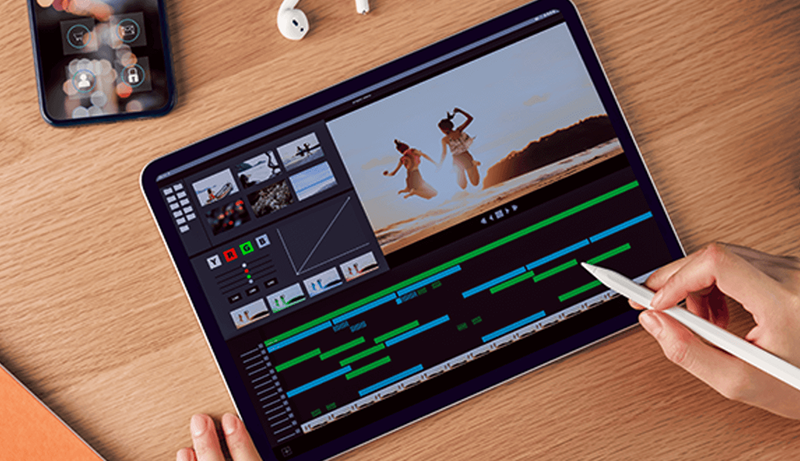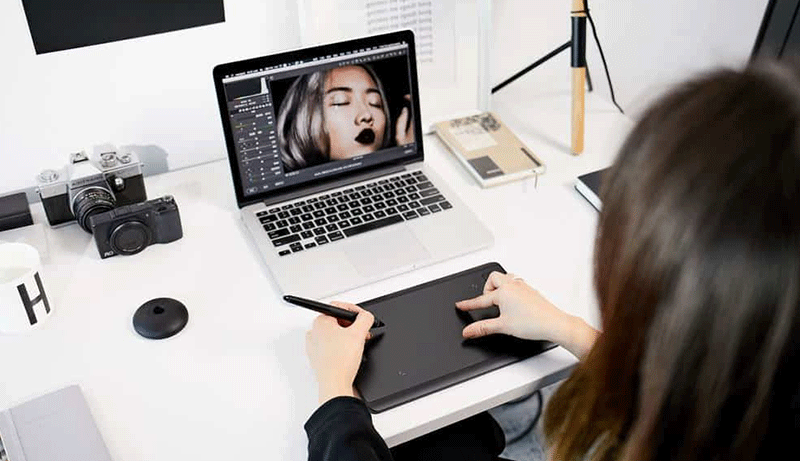Video editing has become a focal point, especially with the exponential growth of the YouTube and influencer community in the past two years. Whether you’re an integral part of this community or a novice looking to enhance raw footage on a secondary device, exploring video editing tablets is crucial.
These tablets are designed to meet the needs of professional video creators or serve as an ideal choice for hobbyists and beginners eager to learn the ropes. Regardless of skill level, certain key attributes should be considered, such as display quality, processing power including the GPU, connectivity options, battery life, and portability.
Despite understanding these features, finding the best tablet for video editing can be challenging. It’s easy to end up with a device lacking a reliable octa-core processor or a top-tier GPU, or compromise on portability. To simplify the selection process, I’ve compiled a list of the top 5 tablets and alternatives for video editing. Importantly, each tablet on the list seamlessly runs popular video editing apps like Premiere Pro, KineMaster, InShot Editor, Final Cut Pro, and LumaFusion without any lag.
Best Tablets For Video Editing Reviews
This discussion delves into various operating systems and corresponding tablets that efficiently run preferred video editing applications. Whether you prioritize premium features or consider budget and skillsets, this review covers a spectrum of options to help you make an informed decision. Let’s dive in!
1. Apple 2020 iPad Air

Our top choice is the Apple iPad Air, a remarkable tablet with significant upgrades over its predecessor. While not as powerful as the iPad Pro, it’s an excellent option for hobbyist video editors and travelers seeking quick-access functionality.
Powered by the M1 chip, a substantial upgrade, the iPad Air ensures smooth software operation and seamless video previewing. The enhanced processing capability makes it suitable for video rendering and utilization of video quality enhancer software.
Starting at 64 GB, storage may be limited for video editing. Opting for the 256 GB variant is recommended, providing more flexibility for storing video files and accommodating larger footage before exporting to another drive.
The 10.9″ Liquid Retina display delivers realistic video footage with P3 color gamut support and an anti-reflective coating, ensuring excellent color, highlights, and shadow reproduction. Even during intensive video editing, the improved battery performs admirably, handling extended processing sessions without issue.
Pros include the fast and efficient Apple M1 chip, high-quality 12 MP cameras for video recording, and fantastic all-day battery life. However, the default storage capacity may be considered lacking, emphasizing the importance of opting for the 256 GB option for an optimal experience.
2. Microsoft Surface Pro 7

For professional video editors seeking a versatile secondary device, the Microsoft Surface Pro 7 stands out, surpassing its predecessor, the Pro 6, thanks to the inclusion of the Wi-Fi 6 wireless standard. The 12.3-inch PixelSense screen, with a resolution of 2736 x 1824 pixels and a 3:2 aspect ratio, is ideal for tasks like video reframing and real-time effects, especially with its 69% DCI-P3 color gamut support for precise color-based editing.
Powered by the 10th gen Intel Core i5 chipset and equipped with Iris Plus graphics, the Surface Pro 7 delivers efficient visual rendering. With 8GB RAM and a 128GB SSD, multitasking is smooth, and storage is ample for essential applications like Premiere Pro.
The tablet boasts a metal build, measuring 11.5 x 7.9 x 0.33 inches and weighing 1.70 pounds. While slightly thicker, it compensates with the fastest wireless standard, multiple USB ports, Bluetooth 5.0, and a Surface Connect Port.
The impressive 10.5-hour battery life enhances outdoor usability, complemented by an 8MP back camera and a 5MP front shooter for capturing images and videos. The Surface Pro 7’s Intel-powered processor ensures top-notch video rendering and editing, distinguishing it as the best tablet for these tasks.
Pros include a fast SSD, Wi-Fi 6 standard, a sharp display, and a feature-packed processing setup. Drawbacks include the need to purchase accessories separately and a slightly bulkier design.
3. SAMSUNG Galaxy Tab S7

The Galaxy Tab S7 stands out as a top-tier Android tablet, ideal for video editing for social media and other moderate tasks. Its Super AMOLED display, a significant improvement over the standard Galaxy Tab S7’s TFT panel, measures 12.4 inches and boasts a 16:10 aspect ratio, providing an exceptional video editing experience with a resolution of 2800 x 1752 and optimal visual angles, even outdoors.
Powered by the Snapdragon 865+ chipset, the Tab S7 handles video editing tasks effortlessly, from effects to fast and slow-motion rendering. With 6GB RAM, it supports the addition of sound and visual effects to multiple videos simultaneously. The 128GB storage unit, expandable up to 1TB, ensures ample space for edited videos and the Android 10 OS.
Aesthetically premium, the Tab S7 weighs only 1.27 pounds, boasting slim dimensions of 11.22 x 7.28 x 0.22 inches. Connectivity features include Wi-Fi 6, Bluetooth 5.0, and a Type-C port for fast charging.
Impressively, the tablet offers a 15-hour battery life, complemented by a dual-camera setup in the rear and an 8MP selfie shooter. The quick fingerprint scanner adds to its user-friendly features.
In conclusion, the Tab S7 excels as the best Android tablet for video editing, particularly for managing social media content. While its performance and battery life rival the iPad Pro, the S7’s price may be a consideration. Alternatively, the Tab S7 FE provides a compelling option with comparable features and a more budget-friendly approach.
Pros include ample RAM, expandable storage, a stunning display, a reliable chipset, and excellent battery life. Drawbacks include limited compatibility with some Android and Windows editing apps and a relatively higher price point.
4. Samsung Galaxy Tab A7

The Samsung Galaxy Tab A7 Tablet is a sophisticated and stylish device crafted to deliver an immersive video editing experience. Boasting a 10.4-inch ultra-widescreen display with a crisp resolution of 2000 x 1200 pixels, it showcases vibrant visuals that bring content to life without sacrificing portability. The tablet’s front-facing landscape-oriented camera enhances its versatility, effortlessly switching between entertainment and video calls.
What sets the Galaxy Tab A7 apart is its quad-speaker system, enriched with Dolby Atmos Surround Sound. This elevates the audio experience, creating a sensation akin to being in the front row of an event. The depth and richness added to the sound contribute to an overall enhanced multimedia experience.
With a robust 7,040mAh battery, the Galaxy Tab A7 ensures extended usage for various tasks. Its powerful processing speeds and expanded memory capacity empower users to engage in more activities they love, from running apps and watching videos to creating playlists.
As an added bonus, the purchase of the Galaxy Tab A7 includes two months of free YouTube Premium and six months of free Spotify Premium, providing additional avenues for entertainment. In conclusion, the Galaxy Tab A7 stands out for its slim design, potent performance, high-quality display, and superior audio capabilities, making it an exceptional choice for video editing and multimedia consumption.
5. ASUS Chromebook Flip C302

The ASUS Chromebook Flip C302 stands out as a versatile 2-in-1 laptop, specifically designed for video editing enthusiasts. Boasting a 12.5-inch Full HD touchscreen and a flexible 360-degree hinge, it effortlessly transitions between tablet and laptop modes. Powered by an Intel Core processor, 64GB storage, and 4GB RAM, this Chromebook delivers swift and efficient performance, catering to demanding editing tasks.
Crafted with a sleek all-metal body weighing just 2.65 pounds, it successfully blends portability with durability. The bright backlit illuminated keyboard enhances usability in diverse environments. With a rapid startup time and an impressive battery life of up to 10 hours, the Chromebook Flip C302 ensures uninterrupted productivity throughout the day.
Additional features like USB Type-C and Corning Gorilla Glass not only contribute to its modern aesthetic but also enhance durability. Operating on Chrome OS, this device provides a secure and streamlined computing experience. Users can easily update the Chrome version for the latest features and security enhancements.
In summary, the ASUS Chromebook Flip C302 makes a lasting impression with its flexibility, high-performance capabilities, and lightweight design. It proves to be an excellent choice for individuals in search of a reliable 2-in-1 laptop for video editing, offering a perfect blend of efficiency and style in a compact and portable package. Users are encouraged to consult the user manual for technical specifications to ensure optimal performance.
Final Verdict
In the realm of video editing, selecting the optimal tablets becomes crucial, responding to the surging demand from both professionals and enthusiasts. Following a comprehensive exploration, the conclusion is evident: the foremost tablets for video editing masterfully balance power, portability, and display quality.
Leading the lineup is the Apple iPad Air, showcasing the formidable M1 chip renowned for its extraordinary processing capabilities, ensuring seamless video rendering. The vivid 10.9-inch Liquid Retina display guarantees precision in color reproduction, rendering it an exceptional choice for visual editing tasks.
The Microsoft Surface Pro 7 stands out as the preferred choice for professional video editors. Its versatile 2-in-1 design seamlessly integrates power and flexibility. Equipped with a 10th Gen Intel Core processor and a high-resolution PixelSense screen, it adeptly addresses the demands of video editing software.
For aficionados of the Android platform, the Samsung Galaxy Tab S7 takes center stage. Featuring a 12.4-inch Super AMOLED display, Snapdragon 865+ chipset, and expandable storage options, it emerges as a powerhouse for managing social media content and on-the-go video editing.
The Samsung Galaxy Tab A7 strikes a balance between performance and affordability. Its 10.4-inch display, coupled with Dolby Atmos Surround Sound and a substantial battery, presents a compelling option for entry-level video editors.
Finally, the ASUS Chromebook Flip C302 distinguishes itself with its versatility and efficient performance. Boasting a 360-degree hinge, Intel Core processor, and a sleek design, it caters to users in search of a dependable 2-in-1 laptop for mobile video editing.
In conclusion, the best tablets for video editing cater to diverse preferences and operating systems. Whether favoring the iOS ecosystem, seeking Windows flexibility, or embracing the Android platform, each tablet on this list brings forth a unique set of features, establishing them as standout choices in the ever-evolving landscape of video editing devices.





Leave a Reply